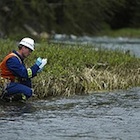Elk Valley water plan approved

A Teck employee conducts water sampling near the company’s Greenhills Operations. — Photo courtesy of Teck Resources Ltd. Environment minister Mary
A Teck employee conducts water sampling near the company’s Greenhills Operations. — Photo courtesy of Teck Resources Ltd.
Environment minister Mary Polak has approved Teck Resources Ltd.’s Area Based Management Plan, submitted to address high levels of selenium and other contaminants in the Elk Valley watershed associated with decades of coal mining activity in the region.
Titled the Elk Valley Water Quality Plan, the plan covers the entire Elk Valley watershed, including Fording River and the Canadian portion of Lake Koocanusa. Its measures will also affect any future decisions regarding water quality in this area and ensure these are made within the context of the entire watershed and not just individual sites.
According to Minister Polak’s office, the Elk Valley Water Quality Plan details how science-based water quality targets established for seven key indicator monitoring stations will mitigate increasing selenium and nitrate concentrations.
An implementation plan sets out how Teck Resources Ltd. plans to achieve these targets in the short term, medium term and long term. Cadmium and sulphate will also be tracked and assessed, along with the planned reduction of calcite formation.
Chris Stannell, senior communications specialist for Teck Resources Ltd., said the company will implement aquatic monitoring, water quality testing and various water quality management measures in order to achieve the target levels in the plan.
“This work is expected to include construction of water diversions and water treatment facilities at a number of our Elk Valley operations,” he said, “including the water treatment facility at Line Creek Operations, which is currently undergoing commissioning, with expected full operation in mid-2015; an additional water treatment facility at Fording River Operations planned for 2018, and an anticipated water treatment facility at Elkview Operations following the Fording River facility.”
Current estimates predict total capital spending on water diversion and water treatment facilities at approximately $600 million over a five-year period. This includes $120 million already invested to build the facility at Line Creek Operations.
The plan also details a monitoring program for the watershed, the results of which will help guide treatment actions and manage future development activities in the watershed.
The Elk Valley Water Quality Plan follows substantial input from regional and federal government, Ktunaxa Nation Council (KNC), Montana and United States experts, and surrounding communities.
Bill Green, director of the Canadian Columbia River Inter-Tribal Fisheries Commission (CCRIFC) said the Ktunaxa Nation Council participated in the process of reviewing the Elk Valley Water Quality Plan, making amendments to the plan and associated documents and identifying a lengthy list of conditions for approval of the plan.
“The KNC has approved the Elk Valley Water Quality Plan, subject to the conditions outlined in the Environmental Management Act Valley Wide Permit, the letter of approval and the letter approving the Regional Aquatic Effects Monitoring Program,” he said. “It is the KNC's view that the conditionally approved plan provides a framework to vigorously seek to improve seriously-impaired water quality conditions in the Elk Valley.”
Green said the extensive collaborative process resulted in a high level of KNC participation in establishing the terms of reference for the Area-Based Management Plan order under the BC Environmental Management Act and in developing the terms of reference for the Elk Valley Water Quality Plan.
“(There was) a high level of technical participation by KNC representatives in the Technical Advisory Committee process established under the ministerial order; and, KNC participation in a BC MoE/Teck/KNC steering committee for the Area-Based Management Plan process,” he said. “The KNC also contributed extensive technical and policy-level consultation about the conditions required to make the EVWQP/ABMP acceptable to the Ktunaxa Nation Council.”
Assured the plan provides the framework to improvement, the KNC will continue to monitor the conditions in the area.
“Ktunaxa Nation Council will be paying very serious attention to early warning indicators of emerging water quality issues within the Ktunaxa Traditional Territory,” said Green.




